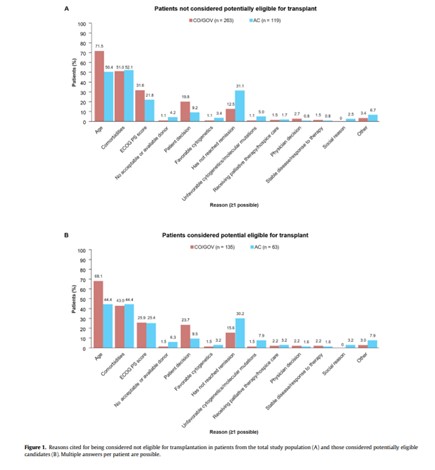This large observation study delves into the referral patterns and considerations of hematopoietic cell transplantation (HCT) for patients newly diagnosed with either high-risk myelodysplastic syndrome (MDS) or acute myeloid leukemia (AML). The primary findings indicate a disparity in HCT eligibility criteria and referral patterns based on site type and patient age. Findings emphasize the necessity to broaden HCT assessment and diminish barriers, ensuring that all potential candidates receive the appropriate care and are seen for HCT consultation.
Download a PDF of the study highlights and citation.
Background
HCT has transformed over the past two decades, with innovations like reduced-intensity and nonmyeloablative conditioning allowing a wider age demographic to benefit. Moreover, the acceptance of using alternative and mismatched donors has expanded, particularly benefiting patients who are racially and ethnically diverse. While patient age, health status and underlying health conditions influence HCT considerations, the focus remains predominantly on the disease characteristics and the patient's fitness.
The motivation for this study arises from the observation that, despite these advancements, the real-world consideration rate for HCT remains unclear.
Study Details
Originating from the Connect Myeloid Disease Registry, this study included patients diagnosed with AML or MDS between Dec. 12, 2013, and Mar. 6, 2020. Inclusion criteria mandated a recent (within 60 days) eligible diagnosis including patients ≥18 years old for MDS and ≥55 years old for AML.
The study evaluated whether patients were considered for transplantation, with three potential classifications: potentially eligible, not considered potentially eligible or not assessed. Further, investigators retrospectively determined eligibility based on various age, health and frailty criteria. By March 2020, 778 patients from 164 locations had enrolled.
Results
A distinction was observed between patients from community/government (CO/GOV) sites and academic (AC) sites in factors like age, geographic location and insurance type.
Regarding transplantation considerations:
- 27.9% of patients from CO/GOV sites and 43.9% of patients from AC sites were viewed as potential candidates.
- 45.1% of patients at CO/GOV sites and 35.7% of patients at AC sites who were considered underwent transplantation.
- The primary reasons for not pursuing transplantation varied by site.
- Insurance type influenced consideration rates, with privately insured patients more frequently deemed eligible.
- Age, especially at CO/GOV sites, predominantly determined the reasons for non-consideration.
A significant portion, 17.4% of the total patients, were not assessed for transplantation. Site disparities were evident here too, with CO/GOV sites showing a higher non-assessment rate.
Based on the investigator-defined eligibility criteria:
- 63.7% of patients at CO/GOV sites and 36.3% of patients at AC sites were potential candidates.
- Age was the principal factor influencing non-consideration across both site types.
Key Takeaways
The study highlights that a significant number of potential HCT candidates with high-risk MDS and AML are not receiving adequate assessment or consideration in clinical practice. Treatment location (CO/GOV vs. AC) and patient age stand out as considerable barriers. A robust push is required to improve access, ensuring that patient care isn't confined by geographical location or the site of treatment. The results stress that more comprehensive strategies are needed to ensure eligible patients are not overlooked for the potential benefits of HCT, especially older patients.
Figure

Tomlinson B, et al., Published in Transplantation and Cellular Therapy
